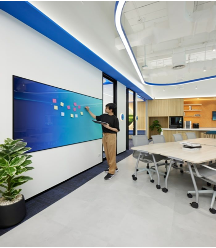Smart Environments: Offices equipped with IoT (Internet of Things) devices for controlling lighting, temperature, and even air quality. Smart sensors can adjust these settings based on the number of people in a room or the time of day.
Advanced Communication Tools: High-quality video conferencing systems, augmented reality (AR) and virtual reality (VR) for immersive meetings, and integrated collaboration platforms that streamline communication.
Sustainable Technologies: Energy-efficient systems, sustainable materials, and waste reduction initiatives. Solar panels, green roofs, and recycling programs might be part of the design.
Personalization and Customization: Allowing employees to personalize their workspaces with adjustable lighting, temperature controls, and even digital interfaces that can be tailored to individual preferences.
AI Integration: Artificial intelligence tools for managing tasks, scheduling, and providing real-time insights. AI can also help in creating optimized layouts and predicting maintenance needs
Enhanced Security: Advanced security systems including biometric access controls, facial recognition, and encrypted communication channels to protect sensitive information.
Robotics and Automation: Use of robots for routine tasks like cleaning or delivering items within the office, and automation systems for streamlining administrative functions.
Dynamic and Adaptive Spaces: Rooms and areas that can be quickly reconfigured using movable walls or smart partitions to support different activities and group sizes.
digital workboards : will be perfect for a wide variety of work tasks such as conducting conference calls, taking notes, giving presentations, and conducting brainstorming sessions .As the technology continues to develop, more and more businesses will find innovative ways to incorporate digital workboards into their everyday activities.
self-sterilizing surfaces: self-sterilizing door handles into the modern workplace. Soon, that same technology will be built into other surfaces including tabletops, windows, refrigerator handles, and bathroom fixtures .Current self-sterilizing door handles use ultraviolet (UV) light to maintain a germ-free surface environment when the handle is not in use.
Floor Plan Light Switch: row after row of light switches can make finding the right balance of on and off more difficult than it should be. The floor plan light switch is the solution to that problem. Instead of a simple on/off toggle, the floor plan light switch displays a layout of your workspace in its entirety (much like a floor plan or a blueprint).When you want to activate or deactivate the lights in a certain room or zone, you simply press that area of the switch. No more flipping random switches on or off in search of the one (or ones) that controls the lights in question.








